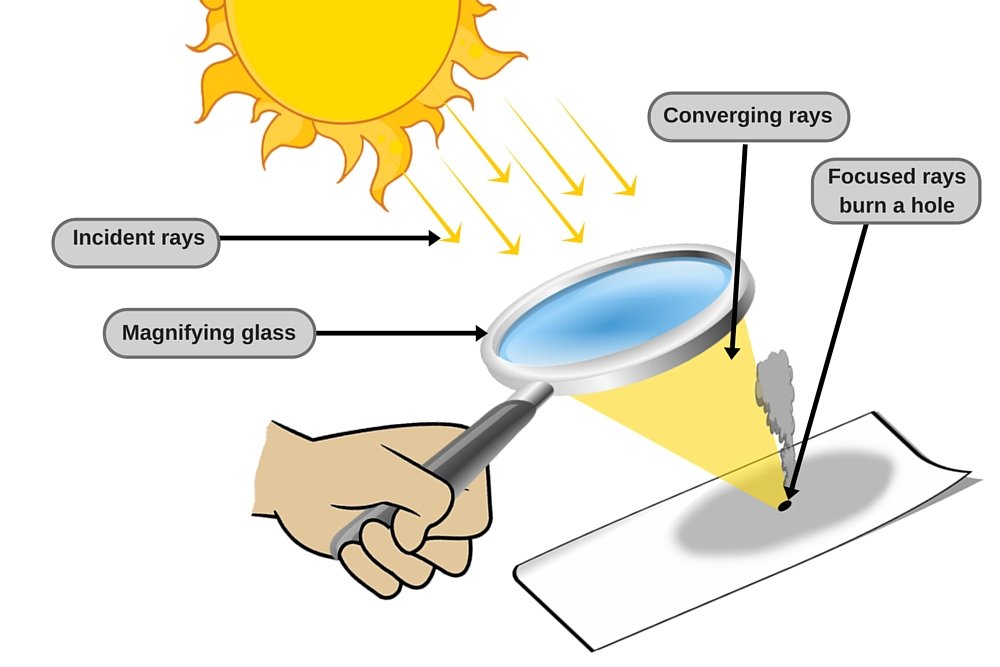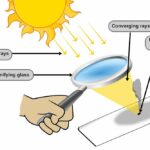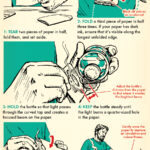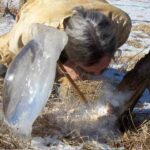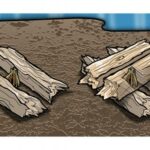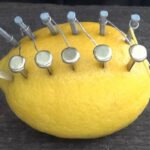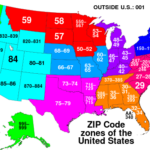Start Fire With Magnifying Glass
1. Locate a sunny area where direct sunlight is available.
2. Position yourself so that the sunlight is shining directly upon the desired spot.
3. Hold the magnifying glass firmly in your hand, making sure it is free from any dirt or debris.
4. Adjust the magnifying glass so that the sunlight passing through it converges into a small, focused point.
5. Place a dry, flammable material such as a small, thin piece of paper or dry leaves on the ground or on a non-flammable surface.
6. Position the magnifying glass approximately 1 to 2 inches above the flammable material, making sure the focused sunlight is directly hitting it.
7. Hold the magnifying glass steadily and patiently, allowing the concentrated sunlight to heat up the material.
8. Move the magnifying glass slightly closer or farther away, or adjust the angle, if needed, to ensure the best concentration of sunlight on the material.
9. Continue to monitor the material as it heats up, applying the focused sunlight for an extended period of time.
10. Keep the magnifying glass steady and avoid any sudden movements that could disrupt the focused sunlight on the material.
11. After a while, start to see smoke rising from the flammable material as it begins to scorch and ignite.
12. Carefully blow on the smoldering material to help facilitate the ignition process.
13. Monitor the ignited material closely to prevent the fire from spreading to undesirable areas.
14. If necessary, gently blow on the flames to help them grow larger and continue burning.
15. Once the fire is established, add more dry flammable material to ensure its sustainability.
16. Be cautious of wind conditions that may affect the fire; position yourself accordingly to shield the flame.
17. Use additional combustible materials like twigs, small branches, or bark to gradually build the fire.
18. Gradually add larger pieces of fuel like logs or wood to keep the fire going.
19. Monitor the fire closely, adding more fuel as needed to maintain the desired size and intensity.
20. Consider constructing a fire pit or using protective barriers to contain the fire and prevent accidental spreading.
21. Never leave a fire unattended, and always have water or a fire extinguisher nearby for safety.
22. If the fire needs to be extinguished, use water or dirt to suffocate the flames until they are completely out.
23. Practice fire safety and ensure that the fire is completely extinguished before leaving the area.
24. Remember to follow any local laws or regulations regarding open fires and ensure proper permission is obtained if necessary.
25. Avoid starting fires in dry or risky areas, such as during hot, dry seasons or in areas prone to wildfires.
26. Wear appropriate protective gear, such as gloves or eyewear, when handling materials or when dealing with potential fire hazards.
27. Avoid aiming the concentrated sunlight at anything other than the intended material to prevent accidental fires or harm.
28. Be aware of your surroundings, making sure there are no flammable objects or materials nearby that could catch fire.
29. Only use a magnifying glass to start a fire in emergency situations or where it is legally permitted.
30. Practice caution and responsibility when using fire, understanding the potential dangers and taking necessary precautions.
More About Start Fire With Magnifying Glass
Title: Harnessing the Power of the Sun: Ignite Your Fire with a Magnifying Glass
Introduction:
In the modern world, we often take for granted the convenience of a lighter or matches when it comes to starting a fire. However, have you ever considered the sheer brilliance of using a simple magnifying glass to ignite a flame? Despite being a method rooted in ancient knowledge, the art of starting a fire with a magnifying glass is not only fascinating but also incredibly useful, especially in situations where survival skills are required.
A magnifying glass, a tool commonly associated with scientific exploration and detective novels, has a hidden potential beyond its apparent simplicity. With a little know-how and some patience, this unassuming instrument can unleash the power of the sun, allowing users to create fire without the aid of modern technology. The technique, known as solar fire starting, has captivated adventurers, survivalists, and outdoor enthusiasts for centuries.
Originating in ancient civilizations, the notion of using the sun’s energy as a source of fire can be traced back to the earliest human endeavors. Indigenous peoples, who relied heavily on fire for warmth, cooking, and protection, discovered the ability to start fires with completely natural materials, and the magnifying glass soon became a valuable tool to augment their capabilities. Even though the technique might seem archaic today, understanding how to harness the sun’s power can be an invaluable skill, ensuring self-sufficiency and survival in various scenarios.
The process of starting a fire with a magnifying glass rests upon the basic principles of optics. When the sun’s rays pass through a convex lens, such as that of a magnifying glass, they converge into a single, concentrated point known as the focal point. This focal point carries an intense heat that, when directed onto a suitable tinder material, can ignite a fire. Essentially, the magnifying glass functions as a concentrated lens, capturing sunlight and intensifying its energy, just like a magnifying glass focusing sunlight to read small print.
However, the art of solar fire starting is not as simple as it appears, demanding a careful understanding of various elements. One crucial factor is the choice of tinder material. Survivalists often turn to char cloth, a porous fabric made from natural fibers, as it readily catches fire due to its high surface area. Alternatively, dried leaves, grasses, or even strands of birch bark can also serve as viable options. Additionally, it is vital to select an appropriate location that ensures maximum exposure to sunlight for the best results.
The skill of fire starting with a magnifying glass is not only a testament to human ingenuity but also an invitation to embrace simplicity in a world dominated by complex technologies. By mastering this ancient technique, we can reconnect with our primal selves, relying on the natural resources that have sustained humanity for millennia. Moreover, understanding the power and energy the sun provides allows us to appreciate its significance in our daily lives, beyond simple illumination a symbol of life, warmth, and sustenance.
In the following articles and guides, we will delve deeper into the intricacies of solar fire starting, exploring various techniques, materials, and scenarios that enable you to master this captivating skill. Whether you are an adventure seeker, a camping enthusiast, or someone looking to prepare for unexpected circumstances, embarking on this journey will undoubtedly expand your knowledge and ignite your sense of self-reliance.
So, grab a magnifying glass, let the sunlight be your guide, and discover the timeless art of starting a fire using one of humanity’s most simple yet effective tools: the magnifying glass.
Start Fire With Magnifying Glass FAQs:
1. How does a magnifying glass start a fire?
Answer: A magnifying glass can concentrate the sun’s rays onto a small spot, increasing the heat and intensity enough to ignite certain flammable materials, such as dry leaves or pieces of paper.
2. What materials can I use to start a fire with a magnifying glass?
Answer: The magnifying glass can be used to ignite various flammable materials, including dry leaves, small pieces of paper, thin twigs, and even certain fabrics that are susceptible to catching fire.
3. Can any magnifying glass start a fire?
Answer: Generally, a magnifying glass with a larger convex lens and a higher magnification power will be more effective at starting fires, as it can focus a larger amount of sunlight onto a smaller spot, increasing the temperature significantly.
4. What are the ideal weather conditions for starting a fire with a magnifying glass?
Answer: The ideal weather conditions include a sunny day with minimal cloud cover. The sun needs to be high in the sky to produce a concentrated beam of light that can generate enough heat to start a fire.
5. Do I need any specific technique to start a fire with a magnifying glass?
Answer: Yes, the key is to hold the magnifying glass a few inches away from the target material and angle it in a way that the concentrated light forms a small, intense spot. This spot should be held steady until the material catches fire.
6. Is it safe to start a fire with a magnifying glass?
Answer: While starting a fire with a magnifying glass can be a useful survival technique, it should only be done in controlled and safe circumstances. Always ensure you have proper clearance for the fire, have proper extinguishing methods nearby, and never use the technique around flammable materials or in dry environments prone to wildfires.
7. How long does it typically take to start a fire with a magnifying glass?
Answer: The time it takes to start a fire largely depends on various factors such as the intensity of sunlight, the flammability of the material being targeted, and the size and quality of the magnifying glass. It could range from a few seconds to several minutes.
8. Can I start a fire at any time of the day with a magnifying glass?
Answer: While it is possible to start a fire with a magnifying glass during most daylight hours, it is often easiest to do so when the sun is directly overhead. This is because the sunlight passes through less atmosphere, reducing the scattering of light and allowing for a more focused beam.
9. Can a magnifying glass start a fire in colder climates?
Answer: Yes, a magnifying glass can still start a fire in colder climates. As long as the sun is shining and there is enough intensity, it is possible to generate the necessary heat to ignite flammable materials.
10. Are there any alternative methods to start a fire in case I don’t have a magnifying glass?
Answer: Certainly! Some alternative methods to start a fire include using other optic devices like eyeglasses or binoculars to focus sunlight, utilizing friction-based methods such as rubbing two dry sticks together vigorously, or using fire-starting tools like matches, lighters, or a fire starter kit.

